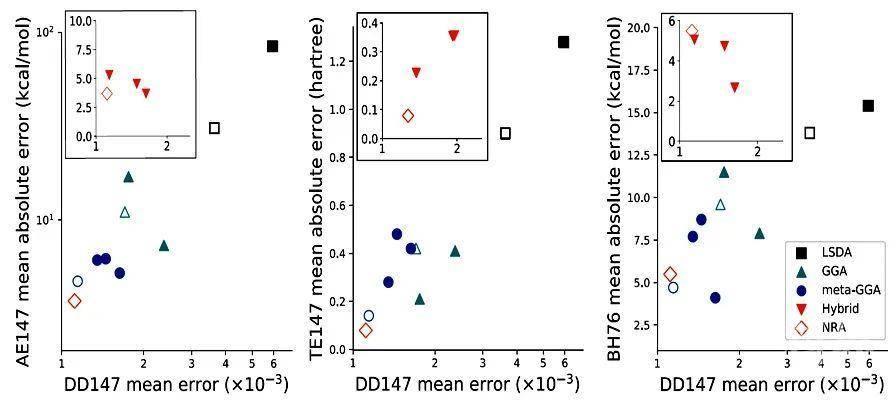科技工作者之家
科技工作者之家APP是专注科技人才,知识分享与人才交流的服务平台。
科技工作者之家 2020-07-23
来源:知社学术圈
基于Kohn-Sham方程的密度泛函理论(DFT)是当前材料计算中最为核心的方法之一。而交换关联泛函又是DFT计算的核心,决定了计算的准确性。为了提高DFT的计算精度,人们构造出来越来越多、越来越复杂的泛函形式,构成所谓的Jacob天梯。然而即便如此,目前仍然没有一种泛函能够准确描述所有材料体系。寻找普适的、高精度的泛函形式是当前DFT发展面临的最重要的问题。
来自东京大学的研究人员证明了利用先进的机器学习技术来构造泛函,从而解决上述密度泛函理论核心问题的可能性。他们采用了基于神经网络的泛函,其具体形式参数取决于实际的电子密度分布。利用参考分子的电子密度分布和原子化能量,他们可以以自洽迭代的方式来训练泛函的形式。该工作的重要性在于,仅基于几个参考分子的数据,即可训练出针对上百种分子给出精确结果的泛函。这一方面是因为泛函构造采用了半局部形式,另一方面是由于在训练集中加入电子密度分布,相当于提供大量不同位置的训练数据。此外,该方法能够构造包含最小假设的泛函形式,如包含非局域变量等,因此可以实现与传统杂化泛函相当的精度,但计算量大幅度降低。由于其灵活的函数形式,这种方法有望用于解决密度泛函计算中更具挑战性的问题,如准确描述范德瓦尔斯和强关联作用等。该文近期发表于npj Computational Materials 6: 43 (2020),英文标题与摘要如下,点击左下角“阅读原文”可以自由获取论文PDF。

Completing density functional theory by machine learning hidden messages from molecules
Ryo Nagai, Ryosuke Akashi & Osamu Sugino
Kohn–Sham density functional theory (DFT) is the basis of modern computational approaches to electronic structures. Their accuracy heavily relies on the exchange-correlation energy functional, which encapsulates electron–electron interaction beyond the classical model. As its universal form remains undiscovered, approximated functionals constructed with heuristic approaches are used for practical studies. However, there are problems in their accuracy and transferability, while any systematic approach to improve them is yet obscure. In this study, we demonstrate that the functional can be systematically constructed using accurate density distributions and energies in reference molecules via machine learning. Surprisingly, a trial functional machine learned from only a few molecules is already applicable to hundreds of molecules comprising various first- and second-row elements with the same accuracy as the standard functionals. This is achieved by relating density and energy using a flexible feed-forward neural network, which allows us to take a functional derivative via the back-propagation algorithm. In addition, simply by introducing a nonlocal density descriptor, the nonlocal effect is included to improve accuracy, which has hitherto been impractical. Our approach thus will help enrich the DFT framework by utilizing the rapidly advancing machine-learning technique.
来源:zhishexueshuquan 知社学术圈
原文链接:https://mp.weixin.qq.com/s?__biz=MzIwMjk1OTc2MA==&mid=2247504879&idx=3&sn=bfd1762a0e065fba2a1299eef0025acc&chksm=96d42d10a1a3a40639aa31ada58801967490a7fe02e569ea713d60e9b8da4f715b2d360ef6a1#rd
版权声明:除非特别注明,本站所载内容来源于互联网、微信公众号等公开渠道,不代表本站观点,仅供参考、交流、公益传播之目的。转载的稿件版权归原作者或机构所有,如有侵权,请联系删除。
电话:(010)86409582
邮箱:kejie@scimall.org.cn

机器学习诞生新型“研究员”

单PdO在BN表面用作甲烷氧化材料的密度泛函理论研究

新型机器学习工具可在疾病爆发前标记危险的细菌

机器学习帮助精确分析黑猩猩行走特征
李群机器学习

机器学习再造无线电

稳态密度泛函理论(Steady-State DFT)解释分子器件中的奇特电子输运现象

专刊简介:机器学习

固体核磁共振谱学结合密度泛函理论计算揭示水-金属氧化物界面的相互作用机制

机器学习软件可以预测细菌行为